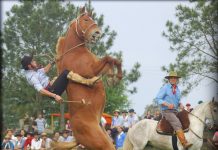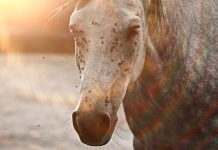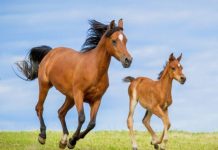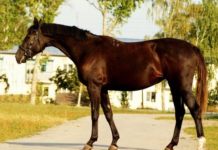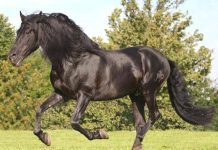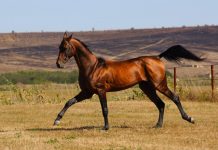Big, strong, and massive – that is the Belgian Brabant. The Brabanter is the oldest and strongest cold blood horse breed.
They come from the Belgian region of Brabant and have been used there as workhorses for agriculture and transport since ancient times.
In this article, you will find all the information you need to know about the mighty, smart, and gentle Brabanter.
Breed description

The Brabanter is a Belgian draft horse breed. The Belgian draft horse is not only known as Brabanter but also as a Flemish horse or Flemish.
The Brabanter is big, massive, and very strong, which makes it the ideal work and draft horse.
The Brabanter can reach a height of between 162 cm and 175 cm and weighs between 700 kg and 1200 kg.
Size: 162-175 cm
Weight: 700 – 1200 kg
Origin: Belgium
Lifespan: 25-30 years
Color: Brown, fox, black and gray of all these colors
Suitable as: Leisure time, draft horse
Origin and breed history
The name of the breed was derived from the region that to this day breeds most of these magnificent draft horses with much love and passion – Brabant in Belgium.
The origin of the Brabant goes back well into Roman times. The Brabant horse probably has its origin in the Flemish horse, but no precise information is available here.
This makes the Belgian draft horse, the Brabant, one of the oldest draft horse breeds. Already in the Middle Ages, the gentle but powerful animals were used as warhorses next to the Ardennes.
The Brabantine quickly became very popular as a warhorse throughout Northern and Central Europe. In 1866 the first Brabant stud book was opened and the association “Le Cheval de Trait Belge” was founded.
In order to keep the breeding as pure as possible – the so-called pure breeding – the breeding was restricted to three bloodlines, namely the lines Colosses de la Mahaique, Gros de la Dentre and Gris des Hainot.
The massive, strong horses were mainly bred by farmers, as they were primarily intended for use as draft horses in agriculture, in addition to being used during the war.
Since big and powerful is synonymous with a lot of meat, these special horses were unfortunately also bred as meat suppliers.
Breeding goal of the association
In 1870 the three bloodlines were established. The first bloodline, or the first breeding line, was Gros de la Dentre. The stallion belonging to this bloodline was Orange I.
This line produced mostly brown foals. The second breeding line, with the stallion Bayard – Gris des Hainot – showed itself predominantly with gray horses, red horses and red foxes.
The third breeding stallion, Jean I., a bay stallion from the Colosses de la Mahaique line, also produced mostly brown offspring.
The descendants of these three stallions were exported to all over the world from the end of the 19th century to the beginning of the 20th century.
They were not only used as workhorses, but also for refinement, as well as for breeding new cold blood horse breeds. Thus, the Brabantians had a significant influence on the appearance and character of other cold-blooded horses all over the world.
The Belgian Draft Horse, which is bred in the USA, is descended from the Brabanter as an example.
The breeding method of the Brabantians
The Brabant or Belgian draft horse is pure bred. However, this does not mean that other, suitable breeds may not be used for grafting in order to achieve the breeding goal.
These horse breeds that are approved for refinement include the Ardennes the Noriker the Percheron draft horse the Schleswig draft horse Breton Cheval de Trait Belge the Shire horse.
The appearance of the Brabantians
The Brabanter reaches a height of up to 175 cm. The building is very strong and massive. However, the Brabant does not look clumsy but is well-proportioned.
The medium-sized, pretty head has a broad forehead, small ears, and attentive and friendly eyes. The forelock and the most light curtains are thick and long.
The neck of the Brabanter is broad and short. It merges into a steep, muscular shoulder and a broad and muscular chest. The Brabantians have low withers, and their backs are short and broad.
The trunk should be deep and well arched. Typical of the Brabantians is the steep, round croup. The legs are of medium length, straight and strong, and are characterized by well-marked, stable and wide joints.
The pasterns are short and steep, the hooves flat and large. The trademark of the Brabantian are the lush köt-hangings on the ankles.
The coat color varies: there are brown, black horses and foxes as well as red, apple, black and fox molds.
Most often one encounters the roan with dark spots and gray hangings. Badges of any kind are permitted.
Temperament and essence

The Brabant horse has a reputation as one of the gentlest, calmest and most good-natured draft horses. They convince with their willingness to learn, their infinite friendliness towards their people and their obedience.
Nervousness or even hectic pace are foreign words for a Brabant. With stoic calm] he also acts in confusing situations.
Highly concentrated and with a tremendous willingness to work, this impressive cold blood does its job.
One could assume that Brabantine knows his enormous power because he is always very careful when dealing with people.
Husbandry and nutrition
Attitude
The Brabanter is easy to care for when it comes to keeping. It is just as suitable for box housing with regular exercise as it is for open stable housing.
Before buying a Brabanter, please only consider that the box size has to be appropriate.
This lovable giant does not fit into a normal box for a warmblood. As with the other cold-blood horse breeds, the box should have a minimum size of 14 square meters to 16 square meters.
A paddock the same size would be ideal. You also need oversized bridles, blankets, bridles, and saddles for your Brabanter. A lot of money can quickly come together here.
Nutrition
The Brabantians used to be used for heavy work. The forage with oats, wheat, and straw was correspondingly high quality and precisely tailored to the needs of the heavy workers, which they were given.
Today the imposing horses have a quieter life. Therefore, you should adjust the feeding to the real needs of the horse, because otherwise, it runs the risk of becoming fat.
The high mineral requirement in these horses and other draft horses is very often underestimated. This can lead to joint diseases, fecal water, eczema, or muck.
It is therefore important to regularly feed sufficient trace elements.
Education and care
Upbringing
The upbringing of these gentle powerhouses is very easy thanks to the willingness to learn and the friendly disposition of the people of Brabant.
These horses are really happy when you are allowed to learn something and are eager and highly concentrated in what they do. Brabanters are among the strongest of the draft horses.
Therefore, the beautiful Brabantians were used as work and draft horses in the past. They were used to pull carriages and wagons and agricultural implements.
The massive Brabantians also cut a fine figure when harvesting wood as a back horse.
Today they pull the festively decorated wagons of the breweries during pageants. They are also popular in the Belgian shrimp fishery, as they can carry heavy loads without any problems.
As a family and leisure horse, the gentle beauties are gaining more and more lovers.
Maintenance
The draft horse is cared for like any other horse. Regular grooming, combing of the ears, mane, and tail, and checking the ears, eyes, and teeth.
The hooves need special attention. It is advisable to look for a farrier in advance who has the necessary tools and experience with cold-blooded horses.
Make sure that the droppings are always clean and dry and take a close look at the hooves when cleaning them since cold-blooded horses can cause more malaise if they are fed incorrectly or excessively.
Health and Typical Diseases
The Brabanter is known as a healthy and robust draft horse. Typical diseases are not found in a Brabantine.
If not enough minerals are fed in, it can also lead to malaise, eczema, fecal water, and degenerative joint diseases in the Brabant horse.
The life expectancy of the Brabantians
Brabanters are generally considered to be very resistant and durable.
With 25 to 30 years of age, friendly draft horses have a very high life expectancy. Are you also interested in other draft horses? How about the Hackney Pony, Breton, or Boulonnais, for example?
Buy Brabant horse breed
You can find a Brabanter through private classified ads or at the corresponding horse markets that also offer their horses online.
It is curious that although this cold-blood horse breed is so popular around the world, there are hardly any special breeders of the Brabantians in Europe.
Even in Belgium directly and in the Netherlands you have to search to find a good breeder. Most of the time, the “breeders” are only owners of stallions.
Depending on what you think about your future cold blood, for example, the age and how far it is already trained and for what purpose you want to buy the Brabanter, there is still the possibility of looking around on the websites for cold blood horses in need.
Here you will find horses of almost all ages and training stages that urgently need to find a new home for various reasons.
Decision support
The Brabanter, also known as the Belgian draft horse or Flemish, is a massive, strong but also very obedient and gentle draft horse.
It is used as a draft horse or carriage horse, in agriculture, or as a back horse for timber harvesting. The Brabant also cuts a fine figure in competitions that involve the strength and endurance of the cold-blooded horses.
The Brabant horse is also suitable for recreational riders and is finding more and more fans in this field. This is not least due to the friendly, people-related nature, his perseverance, his strength, and the great willingness to learn.
A Brabantian is not the most enduring or fastest at a trot or gallop due to its size, but normal rides or trail rides through nature are a lot of fun for the draft horse and its owner.
Useful information

The largest living horse is the Brabant Big Jake. Big Jake was born and raised in the United States. He has a height of 2.10 meters, which is unusual for a Brabant and weighs around 1,200 kilograms.
In 2006 and 2013, Big Jake received an entry in the Guinness Book of Records. His owners love Big Jake and describe him as extremely meek.
But Big Jake is not only big, he also has a big job: Big Jake raises money for the Ronald McDonald House in Madison at various shows. This foundation takes care of seriously ill children and their families.
This foundation takes care of seriously ill children and their families.








